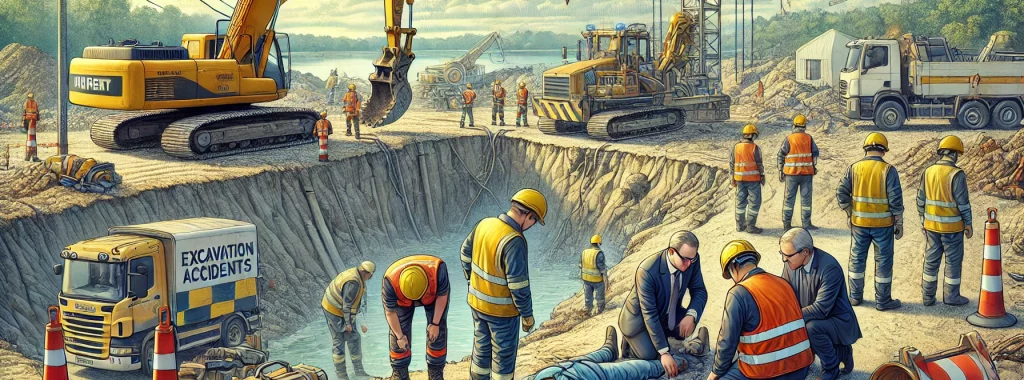
Excavation Accidents and the Law: Understanding Worker Safety and Liability
Without proper safety precautions, excavation accidents during construction can lead to injuries
and even fatalities. To prevent accidents, construction sites must comply with safety guidelines
and regulations, including OSHA (Occupational Safety and Health Administration) standards.
Common Excavation Hazards
Some of the most common excavation hazards on construction sites include the following:
- Cave-ins: One of the most significant risks – and more likely to occur than other types of excavation incidents that can result in fatalities – is the collapse of excavation walls. According to OSHA, one cubic yard of soil can weigh as much as a car. Cave-ins can be due to unstable soil, water infiltration, or insufficient shoring and bracing.
- Falls: If the edges are not adequately protected by barriers or guardrails or if proper access points like ladders or stairs are not provided, workers can fall into an excavated area.
- Falling Loads: Materials, tools, or equipment placed near the edge of the excavation site can fall into the hole, potentially hitting the contractors working below.
- Engulfment: Excavations can fill with water or other liquids, posing a drowning risk. Workers can also become immersed in loose debris or substances during the excavation.
- Hazardous Atmospheres: Excavations can trap toxic gasses and lack sufficient ventilation, posing a risk to workers.
- Utility Strikes: Excavators can mistakenly damage underground utilities such as gas lines, water pipes, and electrical cables, leading to leaks, electrical risks, and explosions.
- Mobile Equipment: Vehicles and machinery near excavation sites can cause collisions or rollovers if not managed properly.
- Confined Spaces: Certain excavations may be categorized as confined spaces, posing extra dangers such as limited access, poor ventilation, and potentially hazardous climatic conditions.
- Spoil Piles: Excavated material along the excavation’s border can pose extra risks, such as collapse or slide.
- Inadequate Exit Routes: If exit routes are not safe and accessible, workers in excavations may struggle to escape in an emergency.
Planning Is Critical
No matter how experienced a construction firm is in excavation work, planning is critical to
mitigate the risk of on-the-job injuries. Many workplace accidents occur because construction firm
owners neglect to adequately perform the initial planning required in excavation projects. One of
the most essential components in planning takes place during the bidding process. Construction
firm owners must get as much information as possible up front to understand the project’s risks
and what safety measures must be implemented.
Factors to consider when evaluating an excavation project include traffic, the proximity and
physical condition of nearby structures, soil classification, surface and groundwater, location of
the water table, overhead and underground utilities, weather, quantity of shoring or required
protective systems, fall-protection needs, number of ladders needed, and other equipment.
Employers should gather the necessary information through site studies, observations, test borings
for soil type or conditions, and consultations with local officials and utility companies. With this
information in hand, they can determine the amount, kind, and cost of safety equipment required
for their employees to work safely.
Excavation Safety Measures
OSHA provides a comprehensive list of safety measures for employers to implement for
excavation projects. These include but are not limited to proper shoring and bracing to ensure that
adjacent structures (including adjoining buildings, walls, sidewalks, and pavement) remain stable
for the protection of workers; regular inspections; training for employees; adequate signage;
protective barriers; confined-space entry procedures; utility positioning; and fall-protection
systems.
Employers must also ensure that materials and equipment are not damaged and are free from
defects. All manufactured materials and equipment used must comply with the manufacturer’s
recommendations.
In addition, according to OSHA, atmospheric testing is required before workers enter an excavation
greater than four feet in depth where an oxygen deficiency or a hazardous atmosphere is present
or could reasonably be expected, such as excavations in landfill areas or in areas where hazardous
substances are stored nearby.
Legal Liability Involving Excavation Accidents
Workers injured during excavation projects are entitled to benefits and compensation under
Workers’ Compensation insurance. Workers’ Compensation pays for medical treatment,
rehabilitation, ongoing medical costs, and lost wages up to a certain amount.
New York also provides additional recourse for construction accidents involving excavation
work. New York Labor Law 241 includes detailed information on how construction, demolition, and
excavation worksites must be arranged and maintained to keep workers safe. Specifically,
according to New York Labor Law 241(6), property owners or contractors (employers) are liable for
negligence if an accident occurs while they control or supervise others. If a property owner or
contractor fails to follow all safety regulations and a worker is injured, the worker has the right to
sue the property owner and employer for compensation.
Call the Law Office of Nicholas E. Tzaneteas
If you or a loved one are injured in an excavation accident and feel it’s due to an unsafe working
environment, call attorney Nicholas E. Tzaneteas. We can review your case to determine whether
New York’s laws were followed and how to proceed. As experienced New York City, Bronx,
Brooklyn, Queens, and Manhattan construction accident attorneys and a personal injury law firm,
we have helped injured clients recover millions of dollars in judgments and settlements.

